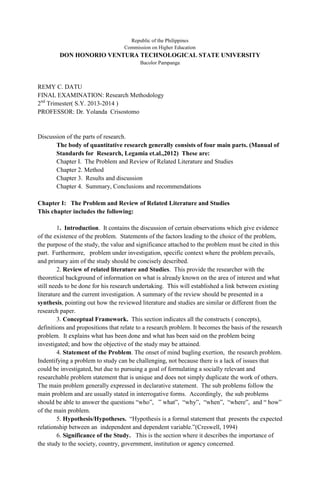
Research methodology parts
- 1. Republic of the Philippines Commission on Higher Education DON HONORIO VENTURA TECHNOLOGICAL STATE UNIVERSITY Bacolor Pampanga REMY C. DATU FINAL EXAMINATION: Research Methodology 2nd Trimester( S.Y. 2013-2014 ) PROFESSOR: Dr. Yolanda Crisostomo Discussion of the parts of research. The body of quantitative research generally consists of four main parts. (Manual of Standards for Research, Legamia et.al.,2012) These are: Chapter I. The Problem and Review of Related Literature and Studies Chapter 2. Method Chapter 3. Results and discussion Chapter 4. Summary, Conclusions and recommendations Chapter I: The Problem and Review of Related Literature and Studies This chapter includes the following: 1. Introduction. It contains the discussion of certain observations which give evidence of the existence of the problem. Statements of the factors leading to the choice of the problem, the purpose of the study, the value and significance attached to the problem must be cited in this part. Furthermore, problem under investigation, specific context where the problem prevails, and primary aim of the study should be concisely described. 2. Review of related literature and Studies. This provide the researcher with the theoretical background of information on what is already known on the area of interest and what still needs to be done for his research undertaking. This will established a link between existing literature and the current investigation. A summary of the review should be presented in a synthesis, pointing out how the reviewed literature and studies are similar or different from the research paper. 3. Conceptual Framework. This section indicates all the constructs ( concepts), definitions and propositions that relate to a research problem. It becomes the basis of the research problem. It explains what has been done and what has been said on the problem being investigated; and how the objective of the study may be attained. 4. Statement of the Problem. The onset of mind bugling exertion, the research problem. Indentifying a problem to study can be challenging, not because there is a lack of issues that could be investigated, but due to pursuing a goal of formulating a socially relevant and researchable problem statement that is unique and does not simply duplicate the work of others. The main problem generally expressed in declarative statement. The sub problems follow the main problem and are usually stated in interrogative forms. Accordingly, the sub problems should be able to answer the questions “who”, ” what”, “why”, “when”, “where”, and “ how” of the main problem. 5. Hypothesis/Hypotheses. “Hypothesis is a formal statement that presents the expected relationship between an independent and dependent variable.”(Creswell, 1994) 6. Significance of the Study. This is the section where it describes the importance of the study to the society, country, government, institution or agency concerned.
- 2. 7. Scope and limitation. It sets the boundaries of the study in terms of the problem, the population and respondents and the setting. 8. Definition of terms. Important terms or variables in the title and unusual technical terms in the study should be defined conceptually. CHAPTER 2. METHODOLOGY According to the materials I have used, this chapter explains the research design. Among the topics included in the research design are the following: 1. METHOD OF RESEARCH USED … It indicates whether the study is experimental, historical, descriptive research or may be a case study. 2. RESPONDENTS OF THE STUDY…Population and the number of respondents 3. SAMPLING DESIGN…Describe the procedure of sampling in detail by stating the size of sample to be used, from what population the sample will be drawn , how participants will be selected and what are the criteria for inclusion of participants in the sample. 4. INSTRUMENT/S…Identifies the instruments to be used in gathering data( Tests, questionnaires, interviews scales, observation, interviews, etc.) 5. DATA GATHERING PROCEDURE… Contains the step- by- step procedure used in the conduct of research. 4. DATA ANALYSES/STATISTICAL TREATMENT… Identify what statistical tools or data analysis technique will be used. CHAPTER 3. RESULTS AND DISCUSSIONS This chapter presents the analysis and interpretation of findings in relation to the research questions and hypotheses. CHAPTER 4. SUMMARY OF FINDINGS, CONCLUSIONS, AND RECOMMENDATIONS 1. Summary of findings… It presents the highlights of the study. A bulk of this section presents the most significant findings of the study, presenting mainly facts without explanation. No new materials should be introduced and its contents must be based entirely on the text of the thesis report(Gregorio, 2000). 2. Conclusion… This contains the most significant findings of the study.It provides answer to the specific objectives and definite answer to the general problem. It should be briefly written, specific, and simply worded. 3. Recommendations… These are statements found at the end of the report that essentially suggest what to do with the findings obtained. They are usually divided into two parts: the recommendations for the utilization of the research findings and those intended for research findings.
